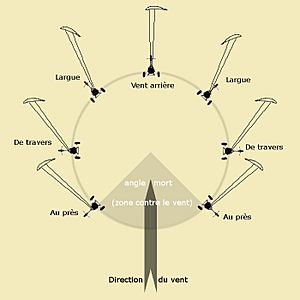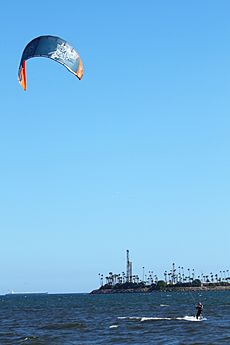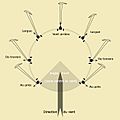Kite rig facts for kids
Kite rigs are special systems that use large kites to help move vehicles. Unlike traditional sails that are attached to tall poles called masts, these kites fly high in the air. They are connected to the vehicle by strong control lines.
Vehicles that use kite rigs include boats, buggies, and even vehicles that glide on snow or ice. Sometimes, it's as simple as a person flying a kite while standing on a special skateboard. Other times, they are huge, complex systems built into a ship, with automated controls. Kite rigs are used for fun activities and also for big commercial ships.
Contents
How Kite Rigs Work
Kite rigs can steer quite close to the wind, about 50 degrees. This means they can even sail against the wind by zig-zagging, a bit like a sailboat does.
A powerful kite is held at an angle to the wind using control lines. Just like any sail, the kite creates two main forces:
- Lift: This pulls the kite upwards and forwards.
- Drag: This pulls the kite backwards.
These forces combine to pull the vehicle. The kite's pull adds to other forces, like water pushing against a boat or wheels on the ground. This combined force moves the vehicle in the direction you want it to go.
The wind usually blows faster and more steadily higher up in the sky. This means kites flying high can get a lot more power from the wind than a regular sail of the same size. Kites can be adjusted to catch the wind best, either by a person or by a computer system. If there's no wind, a kite can't stay in the air and needs to be relaunched.
Fun with Kite Rigs
Kite rigs power many exciting sports on water and land.
- Kitesurfing: On water, kites pull people on surfboard-like boards. It's a very popular and thrilling sport!
- Kiteboating: Kites are also used to power actual boats on the water.
- Kite Landboarding: On land, kites pull people on skateboard-like boards. It's similar to kitesurfing but on solid ground.
- Snowkiting: Over snow, kites pull people on snowboards or skis. It's a great way to explore snowy landscapes.
Kites for these solo sports are usually between 1 and 16 square meters in size. Kites larger than about 5 square meters are considered big and need more skill to handle.
Kite Rigs for Big Ships
Kites used to pull large ships are enormous! They can be hundreds of square meters in size. These huge kites need special places to attach to the ship. They also have systems to launch them into the air and pull them back down. They use computer-controlled systems to steer them.
One famous system is called SkySails. It uses a very large kite that looks like a giant wing. It has an electronic control system for the kite and an automatic system to put the kite away.
Even though it's much bigger, the SkySails kite is a bit like the kites used in kitesurfing. However, it's an inflatable kite, not one that fills with air as it flies. Instead of many lines going directly to the ship, it uses a special control pod. Only one main line goes from the kite to the ship. Smaller lines connect the kite to this control pod. This main line also sends power and commands from the ship to the control pod.
The kite is launched and brought back by a moving mast or arm. This arm grabs the kite and also helps inflate or deflate it. When the kite is not being used, the mast and deflated kite fold away neatly.
How Ships Use Kites
A cargo ship named MS Beluga Skysails was built in 2007. It had a kite rig to help its regular engines. A study found that this ship saved about 5% on fuel overall. This meant it produced 530 tons less carbon dioxide (CO2) in a typical year!
The study also suggested that if 25,000 similar ships used kite sails, they could save a lot of fuel and reduce pollution. Installing a kite sail was estimated to pay for itself in about two to three years. On its first trip, the MS Beluga Skysails saved 10-15% on fuel, which was about $1,000 to $1,500 each day the kite was used.
Another large fishing boat, the Maartje Theadora, also had a kite rig added in 2010.
Images for kids





